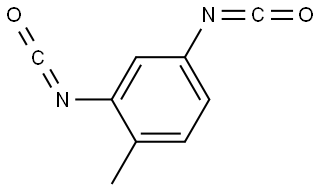584-84-9

Product Name:
Tolylene-2,4-diisocyanate
Formula:
C9H6N2O2
Synonyms:
TDI;Tolylene 2,4-diisocyanate;Toluene 2,4-diisocyanate;2,4-Diisocyanatotoluene;4-Methyl-m-phenylene diisocyanate
Inquiry
CHEMICAL AND PHYSICAL PROPERTIES
| Physical Description | Toluene-2,4-diisocyanate appears as colorless to yellow or dark liquid or solid with a sweet, fruity, pungent odor. Melting point 68 °F (20 °C). Evolves CO2 when moist. This can cause over-pressurization in an enclosed space.Toxic and carcinogenic. Used in polyurethane foams, coatings in floor and wood finishes, sealers, paints, concrete sealers for aircraft and tank trucks, elastomers in clay pipe seals, elastomers and coatings, and crosslinking agent for nylon. Rate of onset: Immediate Persistence: Hours - weeks Odor threshold: 0.4 - 2 ppm Source/use/other hazard: Polyurethane (wood coatings, foam), nylon industries; skin irritant. |
|---|---|
| Color/Form | Water-white to pale yellow liquid |
| Odor | Sharp, pungent |
| Boiling Point | 484 °F at 760 mmHg (EPA, 1998) |
| Melting Point | 67.1 to 70.7 °F (EPA, 1998) |
| Flash Point | 270 °F (EPA, 1998) |
| Solubility | Decomposes (NTP, 1992) |
| Density | 1.2244 at 68 °F (EPA, 1998) - Denser than water; will sink |
| Vapor Density | 6 (EPA, 1998) - Heavier than air; will sink (Relative to Air) |
| Vapor Pressure | 1 mmHg at 176 °F (EPA, 1998) |
| LogP | 3.4 |
| Stability/Shelf Life | Darkens on exposure to sunlight. |
| Autoignition Temperature | greater than 300 °F (USCG, 1999) |
| Decomposition | When heated to decomposition, it emits highly toxic fumes of ... /nitrogen oxides/. |
| Polymerization | The diisocyanate may undergo exothermic polymerization in contact with bases or more than traces of acyl chlorides, sometimes used as stabilizers. |
| Odor Threshold | Odor Threshold Low: 0.05 [mmHg] Odor Threshold High: 2.4 [mmHg] Odor threshold from CHEMINFO [ICSC] Odor threshold = 50 ppb with about 1/2 of volunteers detecting and identifying the material at 400 ppb |
| Refractive Index | Index of refraction: 1.5654 at 25 °C/D |
| Other Experimental Properties | Reacts with compounds containing active hydrogen (may be violent) |
| Chemical Classes | Plastics & Rubber -> Diisocyanates |
SAFETY INFORMATION
| Signal word | Danger |
|---|---|
| Pictogram(s) |
 Skull and Crossbones Acute Toxicity GHS06  Health Hazard GHS08 |
| GHS Hazard Statements |
H315:Skin corrosion/irritation H317:Sensitisation, Skin H319:Serious eye damage/eye irritation H330:Acute toxicity,inhalation H334:Sensitisation, respiratory H335:Specific target organ toxicity, single exposure;Respiratory tract irritation H351:Carcinogenicity H412:Hazardous to the aquatic environment, long-term hazard |
| Precautionary Statement Codes |
P202:Do not handle until all safety precautions have been read and understood. P273:Avoid release to the environment. P280:Wear protective gloves/protective clothing/eye protection/face protection. P302+P352:IF ON SKIN: wash with plenty of soap and water. P305+P351+P338:IF IN EYES: Rinse cautiously with water for several minutes. Remove contact lenses, if present and easy to do. Continuerinsing. |
COMPUTED DESCRIPTORS
| Molecular Weight | 174.16 g/mol |
|---|---|
| XLogP3 | 3.9 |
| Hydrogen Bond Donor Count | 0 |
| Hydrogen Bond Acceptor Count | 4 |
| Rotatable Bond Count | 2 |
| Exact Mass | 174.042927438 g/mol |
| Monoisotopic Mass | 174.042927438 g/mol |
| Topological Polar Surface Area | 58.9 Ų |
| Heavy Atom Count | 13 |
| Formal Charge | 0 |
| Complexity | 265 |
| Isotope Atom Count | 0 |
| Defined Atom Stereocenter Count | 0 |
| Undefined Atom Stereocenter Count | 0 |
| Defined Bond Stereocenter Count | 0 |
| Undefined Bond Stereocenter Count | 0 |
| Covalently-Bonded Unit Count | 1 |
| Compound Is Canonicalized | Yes |
PRODUCT INTRODUCTION
description
Toluene diisocyanate exists in two isomeric forms (2,4-toluene diisocyanate and 2,6-toluene diisocyanate) which have similar properties and effects. Toluene diisocyanate is produced commercially as an 80:20 (2,4-toluene diisocyanate:2,6-toluene diisocyanate) mixture of the two isomers. At room temperature, the mixture is a clear, pale yellow liquid with a sharp, pungent odor. It should be stored under refrigeration, away from light and moisture in a tightly closed container under an inert atmosphere. Toluene diisocyanate is insoluble in water and miscible with most common organic solvents.
RELATED SUPPLIERS
All suppliers(1)